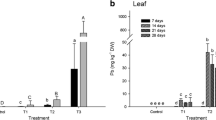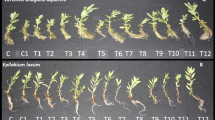Abstract
Contamination with heavy metals in surface and groundwater is a threat to human health and ecosystems. Due to this, the need arises to remediate water polluted through ecological and profitable technologies, such as phytoremediation. The objective of the work was to evaluate the concentration of lead (Pb) and zinc (Zn) in the floating macrophytes Limnobium laevigatum and Ludwigia peploides, after being exposed to contaminated water experimentally. In this way to be able to determine if these plants have mechanisms that allow them to accumulate the metals in the roots and to perform the translocation of these to different vegetative organs, L. laevigatum and L. peploides were placed in solutions contaminated with Pb ([Pb] = 5 mg/l) and Zn ([Zn] = 20 mg/l). The concentrations of metals in water, root and leaf samples were evaluated as a function of time (0, 1, 2 and 4 days). The determination of the metals was performed by the atomic absorption spectrophotometry technique. After 4 days of exposure to Pb and Zn, the plants showed high metal removal efficiencies of water, more to 70% in all cases. Pb was accumulated fundamentally by roots, while Zn was accumulated more in the leaves. In addition, the bioconcentration and translocation factors for each metal were calculated.





Similar content being viewed by others
References
Albornoz CB, Larsen K, Landa R, Quiroga MA, Najle R, Marcovecchio J (2016) Lead and zinc determinations in Festuca arundinacea and Cynodon dactylon collected from contaminated soils in Tandil (Buenos Aires Province, Argentina). Environ Earth Sci 75:742. https://doi.org/10.1007/s12665-016-5513-9
Ali H, Khan E, Sajad MA (2013) Phytoremediation of heavy metals—concepts and applications. Chemosphere 91:869–881
Banda Noriega R, y Díaz A (2010) Estimación de Cargas Contaminantes del Arroyo Langueyú. Tandil Buenos Aires Ciencia 5:157–171
Barry SAS, Clark SC (1978) Problems of interpreting the relationship between the amounts of lead and zinc in plants and soil on metalliferous wastes. New Phytol 81:773–783
Cheng S, Grosse W, Karrenbrock F, Thoennessen M (2002) Efficiency of constructed wetlands in decontamination of water polluted by heavy metals. Ecol Eng 18:317–325
Dean I, Rains T (1975) Flame emission and atomic absorption spectroscopy. In: Alkemade CT, Hollander T, Snelleman W, Zeegers PT (eds) Metal Vapours in Flames International series in natural Philosophy. Dekken Press, New York
Demirezen D, Aksoy A (2004) Accumulation of heavy metals in Typha angustifolia (L.) and Potamogeton pectinatus (L.) living in Sultan Marsh (Kayseri, Turkey). Chemosphere 56:685–696
Deng H, Ye ZH, Wong MH (2004) Accumulation of lead, zinc, copper and cadmium by 12 wetland plant species thriving in metal-contaminated sites in China. Environ Pollut 132:29–40
Fritioff A, Greger M (2003) Aquatic and terrestrial plant species with potential to remove heavy metals from stormwater. Int J Phytoremediation 5(3):211–224. https://doi.org/10.1080/16226510390255661
Gunatilake S (2015) Methods of removing heavy metals from industrial wastewater. J Multidiscip Eng Sci Stud 1:2912–1309
Hadad HR, Maine MA, Mufarrege MM, Del Sastre MV, Di Luca GA (2011) Bioaccumulation kinetics and toxic effects of Cr, Ni and Zn on Eichhornia crassipes. J Hazard Mater 190:1016–1022
Hammad DM (2011) Cu, Ni and Zn phytoremediation and translocation by water hyacinth plant at different aquatic environments. Aust J Basic Appl Sci 5(11):11–22
Hernandez M, Giaconi L, Gonzalez N (2002) Linea de base ambiental para las aguas subterráneas y superficiales en el área minera de Tandilia, Buenos Aires, Argentina. Groundwater and human development (ISBN: 987-544-063-9)
Juned M, Ahmaruzzaman M (2016) A review on potential usage of industrial waste materials for binding heavy metal ions from aqueous solutions. J Water Process Eng 10:39–47
Kähkönen MA, Pantsar-Kallio M, Manninen PKG (1997) Analysing heavy metal concentrations in the different parts of Elodea canadensis and surface sediment with PCA in two boreal lakes in southern Finland. Chemosphere 35:2645–2656
Kamal M, Ghalya AE, Mahmouda N, Cote R (2004) Phytoaccumulation of heavy metals by aquatic plants. Environ Int 29:1029–1039
Kastratović V, Jaćimović Z, Đurović D, Bigović M, Krivokapić S (2015) Lemna minor L. as bioindicator of heavy metal pollution in skadar lake (Montenegro). Kragujevac J Sci 37:123–134
Lasat MM (2000) Phytoextraction of metals from contaminated soil: a review of plant/soil/metal interaction and assessment of pertinent agronomic issues. J Hazard Subs Res 2:1–23
Liao SW, Chang WL (2004) Heavy metal phytoremediation by water hyacinth at constructed wetlands in Taiwan. J Aquat Plant Manage 42:60–68
Lu X, Kruatrachue M, Pokethitiyook P, Homyok K (2004) Removal of cadmium and zinc by water hyacinth, Eichhornia crassipes. Sci Asia 30:93–103
Megateli S, Semsari S, Couderchet M (2009) Toxicity and removal of heavy metals (cadmium, copper, and zinc) by Lemna gibba. Ecotoxicol Environ Saf 72:1774–1780
Miretzky P, Saralegui A, Fernández Cirelli A (2004) Aquatic macrophytes potential for the simultaneous removal of heavy metals (Buenos Aires, Argentina). Chemosphere 57:997–1005
Mishra VK, Tripathi BD (2008) Concurrent removal and accumulation of heavy metals by the three aquatic macrophytes. Biores Technol 99:7091–7097
Nilanjana D, Vimala R, Karthika P (2008) Biosorption of heavy metals—an overview. Indian J Biotechnol 7:159–169
Pandey PK, Verma Y, Choubey S, Pandey M, Chandrasekhar K (2008) Biosorptive removal of cadmium from contaminated ground water and industrial effluents. Bioresour Technol 99:4420–4429
Peng K, Chunling L, Laiquing L, **angdong L, Zhenguo S (2008) Bioaccumulation of heavy metals by the aquatic plants Potamogeton pectinatus L. and Potamogeton malaianus Miq. and their potential use for contamination indicators and in wastewater treatment. Sci Total Environ 392:22–29
Price WJ (1979) Spectrochemical analysis by atomic absorption. Heyden & Son, Incorporated, Lincoln, United Kingdom
Radzali N, Kadir W, Shariff S, Nawahwi M, Wakid S, Jaafar Z, Rahim I (2015) Phytoremediation: environmental-friendly clean up method. World J Environ Pollut 5:16–22
Rezania S, Mat Taib S, Din M, Dahalan F, Kamyab H (2016) Comprehensive review on phytotechnology: heavy metals removal by diverse aquatic plants species from wastewater. Journal of Hazard Mater 318:587–599
Singh R, Tripathi RD, Dwivedi S, Kumar A, Trivedi PK, Chakrabarty D (2010) Lead bioaccumulation potential of an aquatic macrophyte Najas indica are related to antioxidant system. Biores Technol 101:3025–3032
Sinha R, Herat S, Tandon P (2007) Phytoremediation: Role of Plants in Contaminated Site Management. Environmental Bioremediation Technologies, pp 315–330
Soda S, Hamada T, Yamaoka Y, Ike M, Nakazato H, Saeki Y, Kasamatsu T, Sakurai Y (2012) Constructed wetlands for advanced treatment of wastewater with a complex matrix from a metal-processing plant: Bioconcentration and translocation factors of various metals in Acorus gramineus and Cyperus alternifolius. Ecol Eng 39:63–70. https://doi.org/10.1016/j.ecoleng.2011.11.014
Stoltz E, Greger M (2002) Accumulation properties of As, Cd, Cu, Pb and Zn by four wetland plant species growing on submerged mine tailings. Environ Exp Bot 47:271–280. https://doi.org/10.1016/S0098-8472(02)00002-3 [Andra SS, Datta R, Sarkar D, Makris KC, Mullens CP, Sahi SV, Bach SBH (2010) Synthesis of phytochelatins in vetiver grass upon lead exposure in the presence of phosphorus. Plant Soil 326: 171–185. doi: 101007/s11104-0099992-2]
Tangahu B, Abdullah S, Basri H, Idris M, Anuar N, Mukhlisin M (2001) A review on heavy metals (As, Pb, and Hg) uptake by plants through phytoremediation. Int J Chem Eng. https://doi.org/10.1155/2011/939161
Umebese CE, Motajo AF (2008) Accumulation, tolerance and impact of aluminium, copper and zinc on growth and nitrate reductase activity of Ceratophyllum demersum (hornwort). J Environ Biol 29:197–200
Uysal Y, Taner F (2009) Effect of pH, temperature, and lead concentration on the bioremoval of lead from water using Lemna Minor. Int J Phytoremediation 11:591–608. https://doi.org/10.1080/15226510902717648
Veselý T, Tlustoš P, Száková J (2011) The Use of Water Lettuce (Pistia Stratiotes L.) for Rhizofiltration of a Highly Polluted Solution by Cadmium and Lead. Int J Phytoremediation 13:859–872. https://doi.org/10.1080/15226514.2011.560214
Vithanage M, Dabrowska B, Mukherjee A, Sandhi A, Bhattacharya P (2011) Arsenic uptake by plants and possible phytoremediation applications: a brief overview. Environ Chem Lett 10:217–224
Zavoda J, Cutright T, Szpak J, Fallon E (2001) Uptake, selectivity, and inhibition of hydroponics treatment of contaminants. J Environ Eng. 127(6): 502–508
Zhu YL, Zayed AM, Qian JH, Souza M, Terry N (1999) Phytoaccumulation of trace elements by wetland plants. Water Hyacinth J Environ Qual 28:339–344
Acknowledgements
The authors are grateful to the National University of the Center of the Province of Buenos Aires, and mainly, to the Commission of Scientific Investigations (CIC) for the studentship of training that made possible the accomplishment of this work.
Author information
Authors and Affiliations
Corresponding author
Additional information
This article is a part of Topical Collection in Environmental Earth Sciences on IV RAGSU—Advances in Geochemistry of the Surface in Argentina, edited by Dr. Americo Iadran Torres and Dr. Pablo Jose Bouza.
Rights and permissions
About this article
Cite this article
Fernández San Juan, M.R., Albornoz, C.B., Larsen, K. et al. Bioaccumulation of heavy metals in Limnobium laevigatum and Ludwigia peploides: their phytoremediation potential in water contaminated with heavy metals. Environ Earth Sci 77, 404 (2018). https://doi.org/10.1007/s12665-018-7566-4
Received:
Accepted:
Published:
DOI: https://doi.org/10.1007/s12665-018-7566-4




